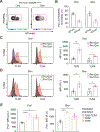Primed inflammatory response by fibroblast subset is necessary for proper oral and cutaneous wound healing
- PMID: 37902166
- PMCID: PMC11058109
- DOI: 10.1111/omi.12442
Primed inflammatory response by fibroblast subset is necessary for proper oral and cutaneous wound healing
Abstract
Fibroblasts are ubiquitous mesenchymal cells that exhibit considerable molecular and functional heterogeneity. Besides maintaining stromal integrity, oral fibroblast subsets are thought to play an important role in host-microbe interaction during injury repair, which is not well explored in vivo. Here, we characterize a subset of fibroblast lineage labeled by paired-related homeobox-1 promoter activity (Prx1Cre+) in oral mucosa and skin and demonstrate these fibroblasts readily respond to microbial products to facilitate the normal wound healing process. Using a reporter mouse model, we determined that Prx1Cre+ fibroblasts had significantly higher expression of toll-like receptors 2 and 4 compared to other fibroblast populations. In addition, Prx1 immunopositive cells exhibited heightened activation of inflammatory transcription factor NF-κB during the early wound healing process. At the cytokine level, CXCL1 and CCL2 were significantly upregulated by Prx1Cre+ fibroblasts at baseline and upon LPS stimulation. Importantly, lineage-specific knockout to prevent NF-κB activation in Prx1Cre+ fibroblasts drastically impaired both oral and skin wound healing processes, which was linked to reduced macrophage infiltration, failure to resolve inflammation, and clearance of bacteria. Together, our data implicate a pro-healing role of Prx1-lineage fibroblasts by facilitating early macrophage recruitment and bacterial clearance.
Keywords: Prx1; fibroblast; immunomodulation; inflammation; regeneration; wound healing.
© 2023 John Wiley & Sons A/S. Published by John Wiley & Sons Ltd.
Conflict of interest statement
Conflict of Interest
The authors have no conflict of interest to declare.
Figures





Similar articles
-
Fibroblast-Mediated Macrophage Recruitment Supports Acute Wound Healing.J Invest Dermatol. 2025 Jul;145(7):1781-1797.e8. doi: 10.1016/j.jid.2024.10.609. Epub 2024 Nov 22. J Invest Dermatol. 2025. PMID: 39581458 Free PMC article.
-
An essential role of the NF-kappa B/Toll-like receptor pathway in induction of inflammatory and tissue-repair gene expression by necrotic cells.J Immunol. 2001 Jun 15;166(12):7128-35. doi: 10.4049/jimmunol.166.12.7128. J Immunol. 2001. PMID: 11390458
-
A non-bactericidal glycine-rich peptide enhances cutaneous wound healing in mice via the activation of the TLR4/MAPK/NF-κB pathway.Biochem Pharmacol. 2025 Jun;236:116912. doi: 10.1016/j.bcp.2025.116912. Epub 2025 Mar 29. Biochem Pharmacol. 2025. PMID: 40164342
-
The Bigger Picture: Why Oral Mucosa Heals Better Than Skin.Biomolecules. 2021 Aug 6;11(8):1165. doi: 10.3390/biom11081165. Biomolecules. 2021. PMID: 34439831 Free PMC article. Review.
-
Macrophages in Skin Wounds: Functions and Therapeutic Potential.Biomolecules. 2022 Nov 8;12(11):1659. doi: 10.3390/biom12111659. Biomolecules. 2022. PMID: 36359009 Free PMC article. Review.
Cited by
-
ICAM1+ gingival fibroblasts modulate periodontal inflammation to mitigate bone loss.Front Immunol. 2024 Nov 22;15:1484483. doi: 10.3389/fimmu.2024.1484483. eCollection 2024. Front Immunol. 2024. PMID: 39650645 Free PMC article.
-
Multi-omics data reveal that SAA1 + fibroblasts exacerbate periodontitis by regulating macrophage inflammation and chemotaxis.J Transl Med. 2025 Aug 7;23(1):882. doi: 10.1186/s12967-025-06925-1. J Transl Med. 2025. PMID: 40775345 Free PMC article.
References
-
- Boothby IC, Kinet MJ, Boda DP, Kwan EY, Clancy S, Cohen JN, Habrylo I, Lowe MM, Pauli M, Yates AE, Chan JD, Harris HW, Neuhaus IM, McCalmont TH, Molofsky AB, & Rosenblum MD (2021). Early-life inflammation primes a T helper 2 cell-fibroblast niche in skin. Nature. 10.1038/s41586-021-04044-7 - DOI - PMC - PubMed
-
- Buechler MB, Pradhan RN, Krishnamurty AT, Cox C, Calviello AK, Wang AW, Yang YA, Tam L, Caothien R, Roose-Girma M, Modrusan Z, Arron JR, Bourgon R, Muller S, & Turley SJ (2021). Cross-tissue organization of the fibroblast lineage. Nature, 593(7860), 575–579. 10.1038/s41586-021-03549-5 - DOI - PubMed
-
- Croft AP, Campos J, Jansen K, Turner JD, Marshall J, Attar M, Savary L, Wehmeyer C, Naylor AJ, Kemble S, Begum J, Durholz K, Perlman H, Barone F, McGettrick HM, Fearon DT, Wei K, Raychaudhuri S, Korsunsky I, Brenner MB, Coles M, Sansom SN, Filer A, & Buckley CD (2019). Distinct fibroblast subsets drive inflammation and damage in arthritis. Nature, 570(7760), 246–251. 10.1038/s41586-019-1263-7 - DOI - PMC - PubMed
MeSH terms
Grants and funding
LinkOut - more resources
Full Text Sources
Molecular Biology Databases
Research Materials

